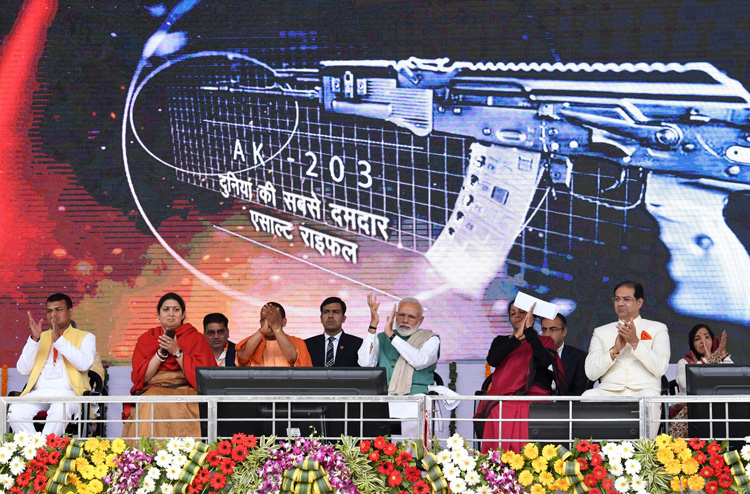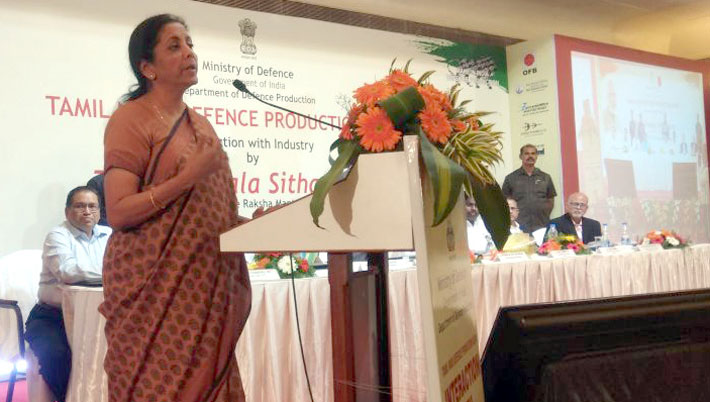INDIAN ARMED FORCES CHIEFS ON OUR RELENTLESS AND FOCUSED PUBLISHING EFFORTS

The insightful articles, inspiring narrations and analytical perspectives presented by the Editorial Team, establish an alluring connect with the reader. My compliments and best wishes to SP Guide Publications.

"Over the past 60 years, the growth of SP Guide Publications has mirrored the rising stature of Indian Navy. Its well-researched and informative magazines on Defence and Aerospace sector have served to shape an educated opinion of our military personnel, policy makers and the public alike. I wish SP's Publication team continued success, fair winds and following seas in all future endeavour!"

Since, its inception in 1964, SP Guide Publications has consistently demonstrated commitment to high-quality journalism in the aerospace and defence sectors, earning a well-deserved reputation as Asia's largest media house in this domain. I wish SP Guide Publications continued success in its pursuit of excellence.
- MoD initiates comprehensive review of Defence Acquisition Procedure 2020, pushes for defence reforms
- G7: The Swansong
- Kalinga Connect: South Asia to Polynesia
- Must Credit DRDO for Operation Sindoor, now what is next for defence R&D?
- The layered Air Defence systems that worked superbly, the key element of Operation Sindoor
- Operation Sindoor | Day 2 DGMOs Briefing
- Operation Sindoor: Resolute yet Restrained
Defence Production & Export Promotion Policy
 |
The Author is Former Director General of Information Systems and A Special Forces Veteran, Indian Army |

On August 3, 2020 the Ministry of Defence (MoD) relased a draft Defence Production and Export Promotion Policy (DPEPP) 2020 whose stated objective is to achieve a turnover of 1,75,000 crores (US$25 billion), including export of 35,000 crores (US$ 5 billion) in aerospace and defence goods and services by 2025. It may be recalled that inaugurating the 11th edition of DefExpo on February 5, 2020 Prime Minister Narendra Modi had said that India is eyeing defence export of $5 billion in the next five years, adding that a country of the size of India cannot entirely depend on imports and that the number of defence licenses issued in the last five years had risen to 460 from 210 in 2014.
The draft DPEPP 2020 aims to reduce dependence on imports and take forward ‘Make in India’ initiatives through domestic design and development, as also promote export of defence products as part of the overall ‘Atmanirbhar Bharat’ policy. DRDO, for instance will set up missions in select fields in consultation with Armed Forces and other scientific and industrial establishments to develop futuristic weapon systems. These range from hypersonic, ballistic and cruise missiles to armourerd vehicles, gas turbine engines, submarines, fifth-generation fighter jets, transport aircraft, robotics and airborne sensors. Multiple strategies have been outlined in the draft DPEPP with focus areas of: procurement reforms; indigenisation and suppot to MSMEs/startups; optimisation of resource allocation; investment promotion; FDI and ease of doing business; innovation and R&D; DPSUs and ordnance factories; quality assurance and testing infrastructure, and; export promotion.

In May 2020, the government had announced that that the Armed Forces will have to shed their penchant for exorbitant weapon systems unless they can be made in India through joint ventures with global armament and aviation majors. Government had also announced that import of certain weapons would be banned through a progressively expanding negative list, while the FDI limit would be hiked to 74 per cent from the existing 49 per cent in the defence production sector through the automatic clearance route.
The draft DPEPP is a typically well-worded document of the MoD but how this will be executed and to what extent, is an altogether different issue. Will this over reaching document to provide a focused, structured and significant thrust to defence production achieve its goals in five years? This question is pertinent because a similar draft policy issued in 2018 that laid out similar goals achieved little. Everytime a new document is issued, it should be mandatory that its preamble or the openng chapter examines why goals set previously were not achieved. But this is avoided by design to cover up default and accountability.
In its annual “Trends in international arms transfers 2019" report, the Stockholm International Peace Research Institute (SIPRI) listed the world’s top five arms importers during the five-year period as Saudi Arabia, India, Egypt, Australia and China. Together, the five accounted for 36 per cent of all arms imports. India remained the world’s second largest arms importer during the period 2015-19. This is the state despite a massive public sector in defence which includes the Defence Research and Development Organisation (DRDO) and its 50 laboratories, four defence shipyards, five defence public sector undertakings (PSUs) and 41 Ordnance Factories (OF) under the Ordnace Factory Board (OFB).
Isn’t it pathetic that despite the massive public defence sector, we are running abroad for helmets, assault rifles, drones, missiles, ammunition, missiles, light tanks and the like amidst the Chinese aggression in Eastern Ladakh. Wasn’t this the same state during the 1999 Kargil Conflict when General V.P. Malik, then Army Chief was constrained to say, “We will fight with what we have”. Over past seven decades no state-of-the-art small arms were produced indigenously and yet the blame is passed on to the Armed Forces for imports of weapons and weapon systems over which they have no control - all imports are handled by the bureaucracy. Presently, the government is engaged in establishing two Defence Industrial Corridors (DICS) in Tamil Nadu and Uttar Pradesh.
No doubt we need a major defence industrial base (DIB) for self-reliance in defence and boosting defence exports as envisaged in draft DPEPP 2020. But we need to urgently address the following issues:
- The governmental defence industrial sector is a while elephant whose output is far below the money it sucks in. Periodic reports of Comptroller and Auditor General have pointed out corruption, sub-standard products with high costs and time delays.
- There is dire need to corporatise the governmental defence industrial sector which is hanging fire because of multiple worker unions aligned with different political parties like BJP, Congress and the Left.
- There is lack of accountability and exessive red tape within MoD hindering ‘Make in India’ as was pointed out to the Prime Minister by the MoS (Defence) two years back.
- Vested interests want indigenous production delayed to facilitate imports. For example, production of AK-203 assault rifles should have already commenced but now a committee is being set up to first decide on the costs.
- Estimated size of our existing defence industry is around 80,000 crores with the public sector contribution being almost 80 per cent. This indicates that the potential of the private sector is not being optimised, which has been pointed out by private sector time and again. The public sector should logically be assigned development of niche technologies with commercialisation of other items left to private sector in defence.
- Politics and favouritism in defence sector should be shunned. Take for example the week old firm of Anil Ambani allotted 36,000 crores as offsets in the Rafale deal which went kaput and now even the clause of offsets has reportedly been dropped in DPP 2020.
- Since past decade, the Department of Industrial Policy and Promotion (DIPP) of the Ministry of Commerce and Industry had been recommending 74 per cent FDI in case of transfer of technology (ToT) and 100 per cent FDI in case of state-of-the-art ToT. Why then we kept dragging the issue from 26 per cent FDI to 49 per cent and eventually 74 per cent - lack of action despite poor FDI?
- We lack of consistency in thought process. A DRDO chief dead against corporatisation favours privatisation when he lands up in Niti Aayog. The CDS said in May 2020 forces must shun imports and accept indigenous weapon systems even if they initially meet 70 per cent of the SQRSs. But when he was the Army Chief, a nine member MoD-Army team went globe-trotting to five countries for assault rifles and carbines – best part being they were not to bring back any weapons as trials were to be held in India.
Finally, the public sector in defence needs to be drastically overhaulled to deliver cutting edge weapon systems without huge time and cost overruns. The private sector must be allowed in defence in a major way. Unless these changes are made, we are not likely to achieve much.





